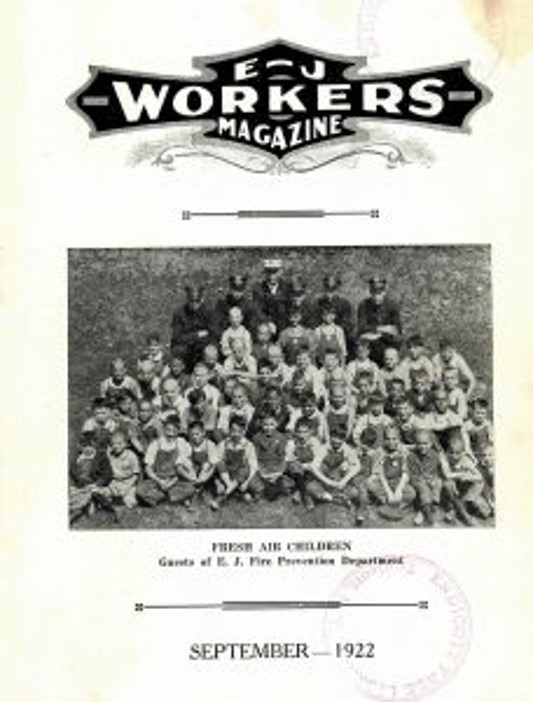The Total-Control Method of the Endicott Johnson Company Management
by Justin Rosenthal
Introduction
The Endicott-Johnson company provided better benefits, built parks and carousels for the town, even built and sold houses to its employees. When starting at a new job at Endicott Johnson, one was given the feeling of being welcomed into a new family. All this was done in order to increase productivity amongst the workers, although the extent of which this company cared about productivity is still in question. How much did the E-J Company truly care about its employees, or was there something else to their management strategy. I believe the company used its resources to gain complete control over their workers lives; both on and off the clock.
Facts
For having no more than twenty thousand employees, the company released in 1925 that it was spending approximately 1.5 million dollars on the construction and sale of houses for its employees, as well as another 1.1 million on the profit sharing plan for the employees. The management was willing to spend nearly three million dollars, or nearly 35 million dollars today, to give them comfortable lives. What the management also got in return was control over their workers entire lives. Living in an Endicott Johnson house meant there was really no escape from the company.
For having no more than twenty thousand employees, the company released in 1925 that it was spending approximately 1.5 million dollars on the construction and sale of houses for its employees, as well as another 1.1 million on the profit sharing plan for the employees. The management was willing to spend nearly three million dollars, or nearly 35 million dollars today, to give them comfortable lives. What the management also got in return was control over their workers entire lives. Living in an Endicott Johnson house meant there was really no escape from the company.

E-J Workers Review
An Endicott Johnson Workers Review from 1919 showcasing George F. Johnson surrounded by his family.
Facts
These methods used by the Endicott Johnson company management seemed to be effective, and these were even enforced in issues of the Endicott Johnson Workers Magazine. One issue from 1925 discusses the profit sharing opportunities provided by the company, and those who take advantage of it. George F. Johnson, the author of the article, discusses his concern and disgust with those who do the bare minimum for as much money as they can get. These articles in company provided magazines seem to reinforce the idea of managements desire for control and docility over the workers. This article also tells us however that not all of the workers were convinced of this paternalistic method of management and took advantage of the system as method of rebellion without appearing as though they were committing patricide.
These methods used by the Endicott Johnson company management seemed to be effective, and these were even enforced in issues of the Endicott Johnson Workers Magazine. One issue from 1925 discusses the profit sharing opportunities provided by the company, and those who take advantage of it. George F. Johnson, the author of the article, discusses his concern and disgust with those who do the bare minimum for as much money as they can get. These articles in company provided magazines seem to reinforce the idea of managements desire for control and docility over the workers. This article also tells us however that not all of the workers were convinced of this paternalistic method of management and took advantage of the system as method of rebellion without appearing as though they were committing patricide.
Conclusion
The company dedicated several millions of dollars to try and make these workers feel apart of a bigger family, and seemingly tried to force the concept of communalism onto its employees. It is possible that the Endicott Johnson company wanted something beyond worker performance; complete control over its workers. There is no doubt that many workers loved the Endicott Johnson company and saw George F. Johnson as a father figure, but looking shows that there were those who did not want to be controlled by the management. After going through these sources, I can come to the possible conclusion that the end goal of management was trying to maintain the best worker performance by controlling as many aspects of their employees lives as possible.
The company dedicated several millions of dollars to try and make these workers feel apart of a bigger family, and seemingly tried to force the concept of communalism onto its employees. It is possible that the Endicott Johnson company wanted something beyond worker performance; complete control over its workers. There is no doubt that many workers loved the Endicott Johnson company and saw George F. Johnson as a father figure, but looking shows that there were those who did not want to be controlled by the management. After going through these sources, I can come to the possible conclusion that the end goal of management was trying to maintain the best worker performance by controlling as many aspects of their employees lives as possible.
Bibliography
- Gerald Zahavi. Negotiated Loyalty: Welfare Capitalism and the Shoeworkers of Endicott Johnson, The Journal of American History, Vol. 70, No. 3, page 607
- Endicott Johnson Shoe Company "An E-J. Workers First Lesson in the Square Deal," pamphlet (19221), box 19, George F. Johnson Papers
- George F. Johnson, “E-J Workers Magazine,” Advertising Building, Endicott Johnson Company. July 1st 1925.
- "E-J Workers Review." George F. Johnson Memorial Library. September 1919-June 1925. http://www.gfjlibrary.org/databases/endicott-johnson-publications/.
- Vintage Worker, “George F. Johnson & the Endicott Johnson Shoe Company” San Fernando Mercantile Co. Blog, October 2010. http://www.vintageworkwear.com/2010/10/george-f-johnson-endicott-johnson-shoe.html
- "E-J Workers Review." George F. Johnson Memorial Library. June 1925 http://www.gfjlibrary.org/databases/endicott-johnson-publications/.
- "E-J Workers Review." George F. Johnson Memorial Library. September 1919 http://www.gfjlibrary.org/databases/endicott-johnson-publications/
- "E-J Workers Review." George F. Johnson Memorial Library. September 1922 http://www.gfjlibrary.org/databases/endicott-johnson-publications/.
